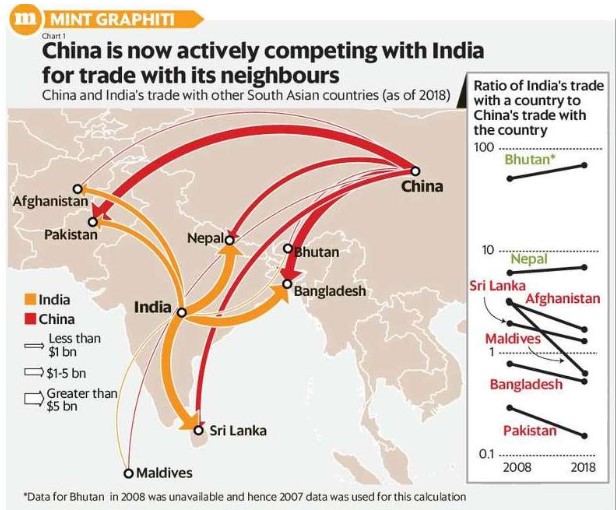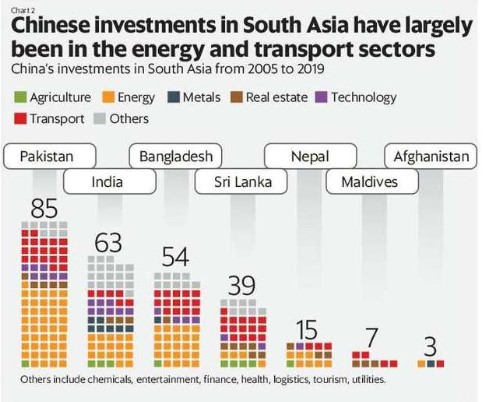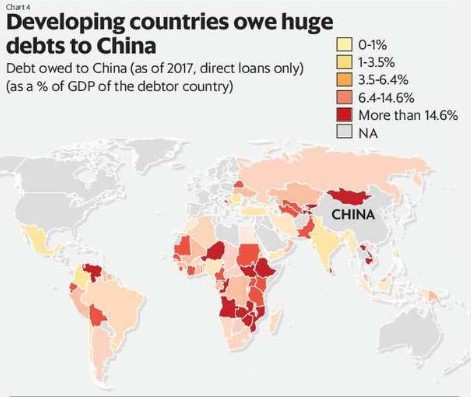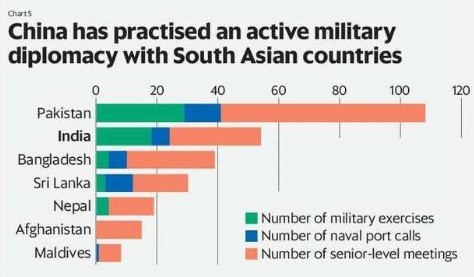Contents
- China’s Rising clout in South Asia
- Reviving SAARC to deal with China
- Utilise MGNREGA to the fullest capacity
CHINA’S RISING CLOUT IN SOUTH ASIA
Focus: GS-II International Relations
Introduction
- Over the past decade, China has boosted its economic and military ties with India’s South Asian neighbours, which could pose a challenge for India.
- Even as some strategic experts warn of a Chinese hand behind the strain in India-Nepal ties, they warn that growing Chinese influence in the region could pose a challenge for India in the rest of South Asia as well.
China taking Control over Trade
- Over the past decade, China has replaced India as the major trading partner of several South Asian countries.
- The share of India’s trade with Maldives was more than 3 times that of China’s in 2008. However, by 2018, China’s total trade with Maldives slightly exceeded that of India.
- China’s trade with Bangladesh is at present about twice that of India.
- China continues to lag India in its trade with Nepal and Sri Lanka, though the gap has shrunk.
- China is now the largest overseas investor in the Maldives, Pakistan, and Sri Lanka.

What does China invest in?
- Chinese investment is concentrated in hard infrastructure – power, roads, railways, bridges, ports and airports.
- Nearly 80% of Chinese investments in South Asia have been in the energy and transport sectors.
- China has also invested in the financial systems of these countries.

China and Debt Trapping
- China is accused of extending excessive credit with the intention of extracting economic or political concessions when countries cannot honour their debts.
- This raises fears that China’s credit to its South Asian partners, particularly via the Belt and Road Initiative (BRI), could be a strategic disadvantage for India.
- Sri Lanka had to lease out its Hambantota Port to China for 99 years, after being unable to service its debt.
- There is economic rationale for China in building alternative access to the Arabian sea to facilitate trade.

China and Military Diplomacy
- China is the biggest arms supplier to Pakistan and Bangladesh.
- Beijing is helping strengthen the navies of Pakistan, Bangladesh, and Sri Lanka to enhance their footprint in the Bay of Bengal and the Indian Ocean.
- Some experts see this as part of an encirclement or ‘string of pearls’ strategy to contain India by building a network of military and commercial facilities in the country’s neighbourhood.

Handling the situation
- While India’s understaffed diplomatic cadre and slower economic growth have been limiting factors, the inability to handle the sensitivities of its neighbours may have also contributed to the turbulence in the neighbourhood.
- The threat of Chinese presence in South Asia can be tackled more effectively if India changes course in its dealings with its neighbours and becomes more sensitive to their concerns.
-Source: Livemint
REVIVING SAARC TO DEAL WITH CHINA
Focus: GS-II International Relations
Introduction
- As India-China border tensions continue to fester China is chipping away at India’s interests in South Asia.
- China’s proximity to Pakistan, Nepal moving closer to China and China wooing Bangladesh by offering tariff exemption to 97% of Bangladeshi products – can be a major cause for concern.
- Most South Asian nations are now largely dependent on China for imports despite geographical proximity to India.
Reinvigorating SAARC
- Several foreign policy experts argue that India’s strategic dealing with China has to begin with South Asia.
- In this regard, it is important to reinvigorate SAARC as India’s political interest in SAARC dipped significantly (due to increasing animosity with Pakistan).
- India has been trying hard to isolate Pakistan internationally for its role in promoting terrorism in India.
What about Bimstec?
- India has invested in other regional instruments, such as BIMSTEC, as an alternative to SAARC, however, BIMSTEC cannot replace SAARC for reasons such as lack of a common identity and history among all BIMSTEC members.
- Moreover, BIMSTEC’s focus is on the Bay of Bengal region, thus making it an inappropriate forum to engage all South Asian nations.
How to revive SAARC?
- Reviving the process of South Asian economic integration is an important step as South Asia is one of the least integrated regions in the world with intra-regional trade teetering at barely 5% of total South Asian trade, compared to 25% of intra-regional trade in the ASEAN region.
- India should take the lead and work with its neighbours to slash the tariff and non-tariff barriers.
- There’s a need to resuscitate the negotiations on a SAARC investment treaty, pending since 2007.
- The SAARC region can likewise benefit from higher intra-SAARC investment flows.
Domestic challenges
There are two major domestic challenges that India faces in revitalising SAARC:
- There has been an unrelenting top-dressing of anti-Pakistan rhetoric and Islamophobia on the Indian soil- to reap political dividends at home. There’s also a recurrent use of the ‘Bangladeshi migrant’ rhetoric. It dents India’s soft power of being a liberal and secular democracy, which gives moral legitimacy to India’s leadership in the region.
- The economic vision with slogans of atma nirbharta (self-reliance) and ‘vocal for local’ should not indicate a return to the obsolete economic philosophy of import substitution. If this marks sliding back to protectionism, one is unsure if India will be interested in deepening South Asian economic integration.
Click Here to read more about SAARC
-Source: The Hindu
UTILISE MGNREGA TO THE FULLEST CAPACITY
Focus: GS-II Social Justice
Introduction
- The role of the Mahatma Gandhi National Rural Employment Guarantee Act (MGNREGA) is a lifeline for the working poor in rural India.
- With an average 23 days of work and a daily wage of ₹200, households who got work earned an average of ₹1,500 a month.
- Even though this is meagre, it shows the potential of MGNREGA to bring work and relief, provided it is further expanded.
- With the return of migrant workers to their home States and with substantial numbers having completed the quarantine period, the demand for work is bound to increase.
Work provided to few
- According to figures available on the Ministry’s website, in this fiscal year, more than 8 crore workers demanded work, but work was provided only to 6.25 crore workers.
- In U.P., over one crore workers had applied for work under MGNREGA, but more than one third of them were turned back.
- In spite of a legal provision of unemployment allowance not a single rupee in compensation has been paid.
- During the rainy season even though demand is high, work provision is low.
- It is therefore essential for the Central government to ensure that States are provided with the funds to pay unemployment allowance to all workers demanding work.
PMGKRA New Scheme’s Concerns
The Pradhan Mantri Garib Kalyan Rojgar Abhiyaan, to provide work to migrant workers in 116 selected districts, while there is an existing need to strengthen MGNREGA, there are a few concerns raised:
- The criteria for selection in the view that some states already had a poor record of implementation of MGNREGA.
- In the list of 25 kinds of work available under Garib Kalyan Rojgar Abhiyaan – most of them are already covered under the convergence programmes of MGNREGA.
- No clarification regarding how the new scheme impact the MGNREGA work in these selected districts.
Potential for MGNREGA
- MGNREGA should not be diluted in the name of the Garib Kalyan Rojgar Abhiyaan.
- The potential for MGNREGA to provide relief to the suffering of rural India should be utilised to its fullest capacity.
- This will also require a removal of the restriction of only one person per household to make every individual eligible.
- Unemployment allowance should be guaranteed for all those turned away from work.
Click Here to read more about the MGNREGA Scheme
-Source: The Hindu





